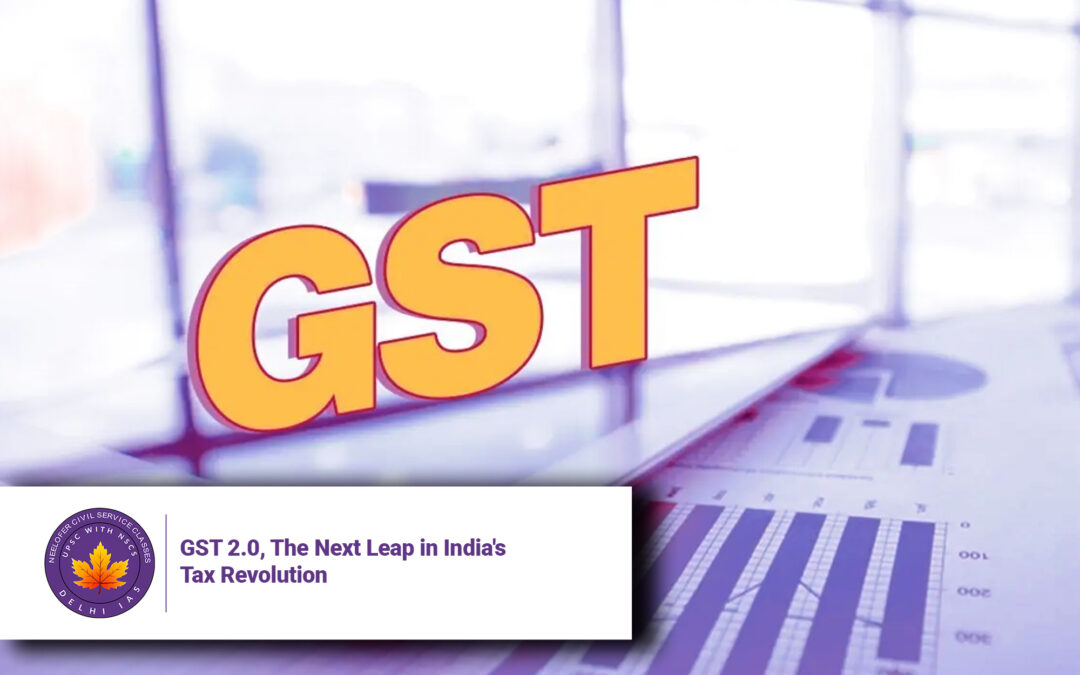GST 2.0, The Next Leap in India’s Tax Revolution
Introduction
Eight years after its groundbreaking implementation, India’s Goods and Services Tax (GST) regime is poised for a transformative upgrade. The proposed GST 2.0 reforms, announced by Prime Minister Narendra Modi on Independence Day, aim to address long-standing structural issues while positioning India’s tax system for a $5 trillion economy. This comprehensive analysis examines:
-
Key pillars of the GST 2.0 reform package
-
Sector-specific impacts and benefits
-
Implementation challenges and timelines
-
Global comparisons and best practices
-
5 Key Q&A on the reforms’ implications
The GST Journey: From Disruption to Maturity
GST 1.0 (2017-2024) Achievements
| Metric | 2017 | 2024 | Improvement |
|---|---|---|---|
| Number of tax slabs | 6+ | 4 | 33% reduction |
| Taxpayer base | 6.5 million | 14 million | 115% growth |
| Monthly collections | ₹0.89 lakh cr | ₹1.87 lakh cr | 110% increase |
| Compliance time | 15 hours/month | 8 hours/month | 47% reduction |
Source: CBIC, CII Analysis
GST 2.0: The Reform Blueprint
1. Rate Rationalization
-
Current Structure: 5 rates (0%, 5%, 12%, 18%, 28%) + cess
-
Proposed Structure:
-
Standard Rate: 14-16% (covering 70% of items)
-
Merit Rate: 5-8% (essential goods)
-
Demerit Rate: 28%+cess (luxury/sin goods)
-
Exemptions: Limited to <50 items (vs 200+ currently)
-
2. Inverted Duty Correction
| Sector | Current Issue | GST 2.0 Solution |
|---|---|---|
| Textiles | 5% on fabric vs 12% on yarn | Uniform 12% rate |
| Footwear | 5% under ₹1,000 vs 18% inputs | Two-tier structure |
| Renewable Energy | 5% on panels vs 18% on components | Rate alignment |
3. Compliance Revolution
-
Automated Processes:
-
Pre-filled returns using AI/ML
-
Real-time invoice matching
-
<24 hour refund processing
-
-
MSME Focus:
-
Composite scheme threshold ↑ to ₹2 crore
-
Quarterly returns for <₹5 crore turnover
-
Economic Impact Assessment
Projected Benefits (2025-30)
| Area | Impact | Monetized Benefit |
|---|---|---|
| GDP Growth | +0.5% annual boost | ₹15 lakh crore |
| Inflation | 1-1.5% reduction in CPI | ₹3.2 lakh cr savings |
| Export Competitiveness | 3-5% cost advantage | $12B additional exports |
| Formalization | 8 million new taxpayers | ₹1.8 lakh cr revenue |
*CII-IMFR Joint Study 2024*
Implementation Roadmap
Phase-wise Rollout Plan
-
Consultation Phase (Aug-Dec 2024)
-
Sectoral working groups
-
State finance ministers’ inputs
-
-
Legislative Phase (Jan-Mar 2025)
-
GST Council approvals
-
CGST/IGST amendment bills
-
-
Pilot Testing (Apr-Jun 2025)
-
5 states, 3 sectors
-
-
Full Implementation (Jul 2025)
-
New return system
-
Rate restructuring
-
Global Lessons: What India Can Learn
Comparative GST/VAT Structures
| Country | Standard Rate | Reduced Rates | Key Feature |
|---|---|---|---|
| Singapore | 9% | 0% (essential) | Single-rate focus |
| Australia | 10% | 0% (fresh food) | No state GST |
| Canada | 5% (federal) | 0-10% (provincial) | Dual system |
| India 2.0 | 14-16% | 5-8% | Hybrid model |
5 Key Q&A on GST 2.0
Q1: How will GST 2.0 impact common consumers?
A: Expected benefits include:
-
Price Reduction: 5-8% on 300+ daily-use items
-
Simpler Compliance: Unified bills for multi-state purchases
-
Faster Refunds: 7-day processing for e-commerce sellers
Q2: What sectors gain most from inverted duty correction?
A: Top beneficiaries:
-
Textiles: 8% cost reduction potential
-
Pharma: API manufacturers see 5% margin improvement
-
EV Components: Battery makers gain 3-4% competitiveness
Q3: Will states lose revenue under the new structure?
A: Safeguards include:
-
5-year compensation extension
-
Revenue-neutral rate (RNR) calibration
-
Growth-linked compensation formula
Q4: How does this compare to global best practices?
A: India’s hybrid model balances:
-
EU’s multi-rate welfare approach
-
Singapore’s compliance simplicity
-
Canada’s federal-state coordination
Q5: What are the biggest implementation risks?
A: Critical challenges:
-
IT Systems: GSTN upgrade scalability
-
SME Adaptation: 65% still use manual accounting
-
Fraud Prevention: AI-based audit capabilities
The Road Ahead: Making GST 2.0 Work
Stakeholder Action Plan
| Group | Key Responsibilities |
|---|---|
| Government | Fast-track dispute resolution |
| Industry | Invest in ERP integration |
| Tax Professionals | Upskill on new compliance |
| Consumers | Demand GST-transparent pricing |
Long-Term Vision
By 2030, GST 2.0 aims to achieve:
-
95% taxpayer compliance (vs 72% today)
-
<3% GST-related litigation (vs 18% now)
-
₹3 lakh crore monthly collections
Conclusion: A Tax System for New India
As Chandajit Banerjee emphasizes, GST 2.0 represents more than technical tweaks—it’s a strategic overhaul to fuel India’s economic ambitions. By addressing structural flaws while enhancing ease of business, these reforms could:
Boost manufacturing competitiveness through duty correction
Formalize ₹10 lakh crore of informal economy
Position India as global benchmark for tax governance
The success of this “second independence” in tax policy will depend on collaborative implementation—but if executed well, GST 2.0 could become the cornerstone of India’s developed economy vision.
Author
Chandajit Banerjee
Director General, Confederation of Indian Industry (CII)







